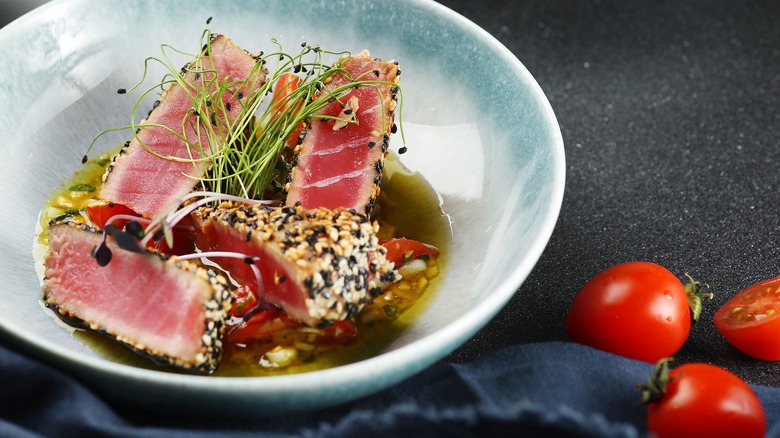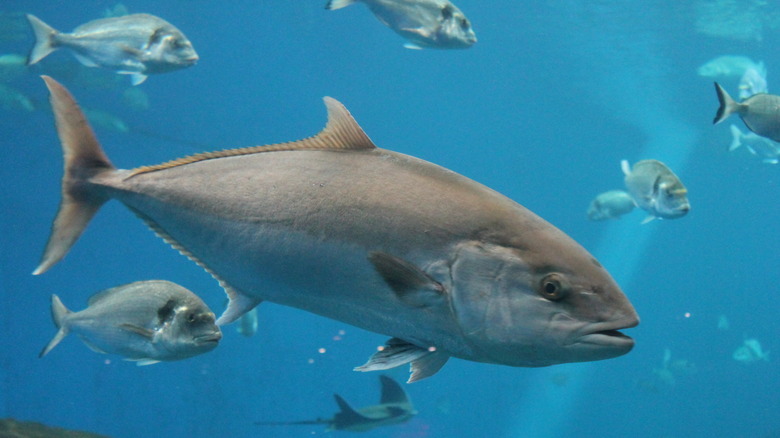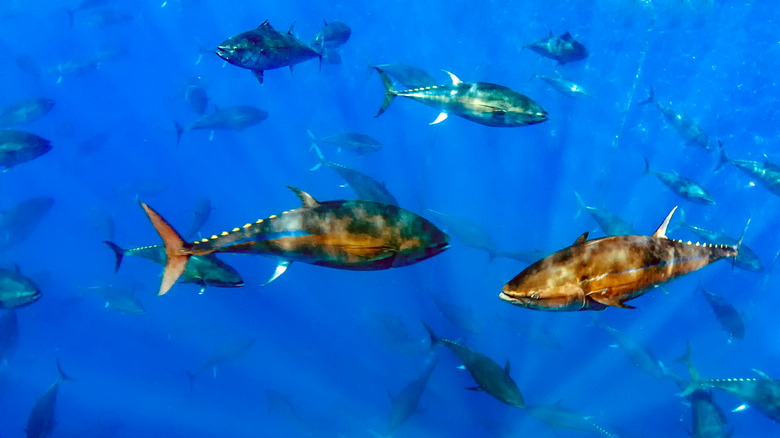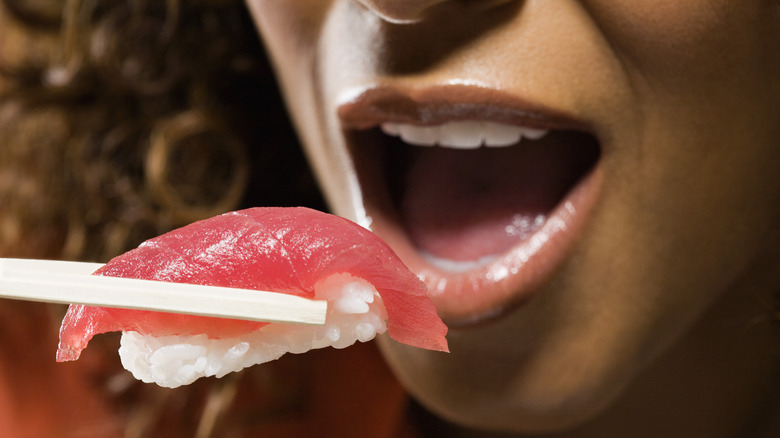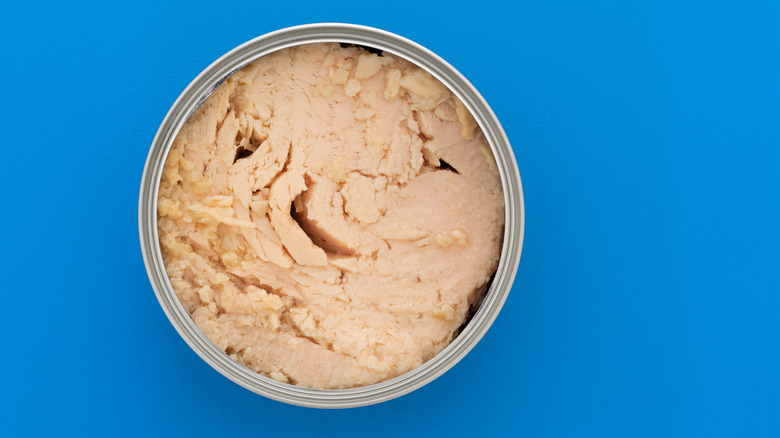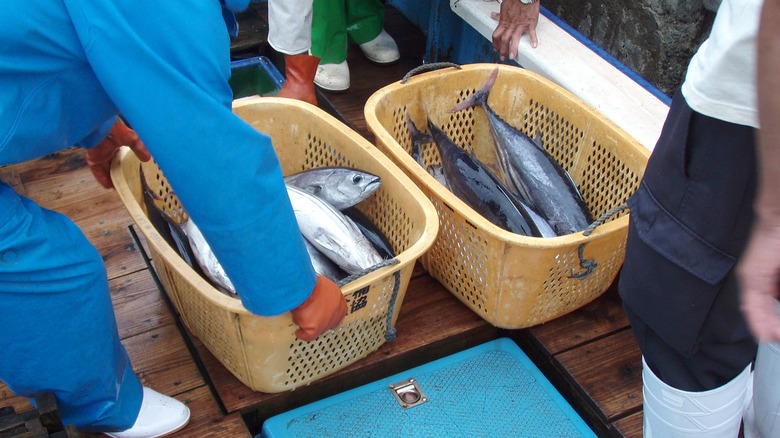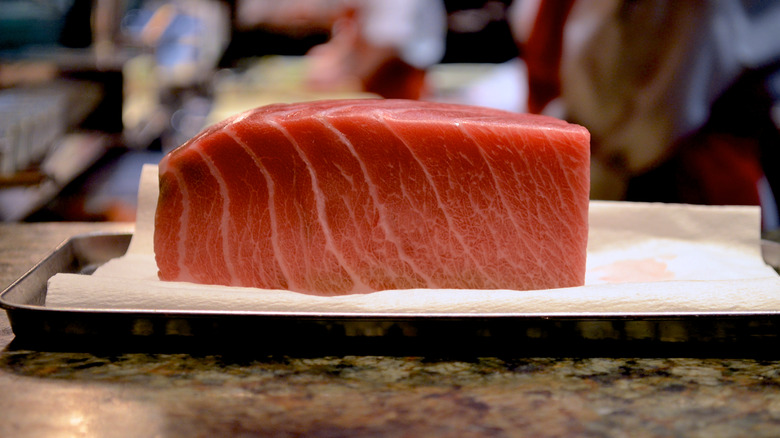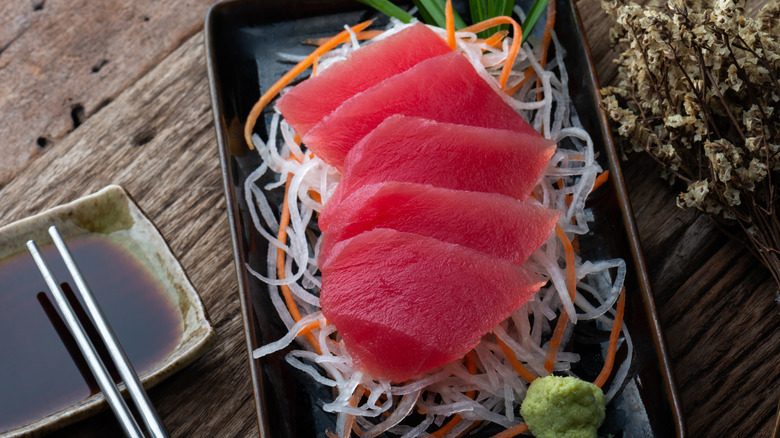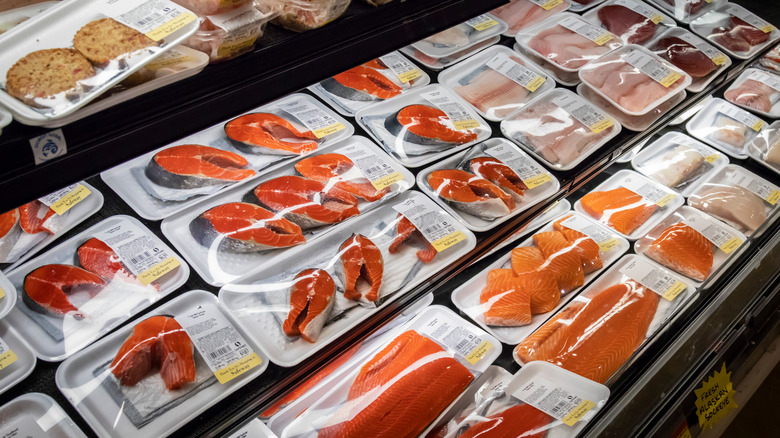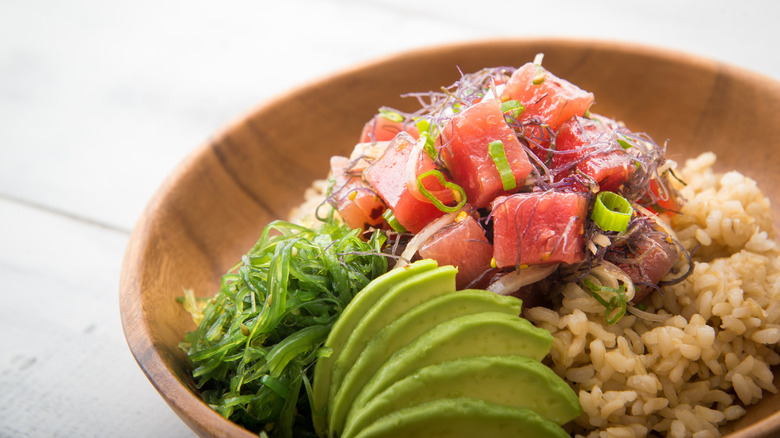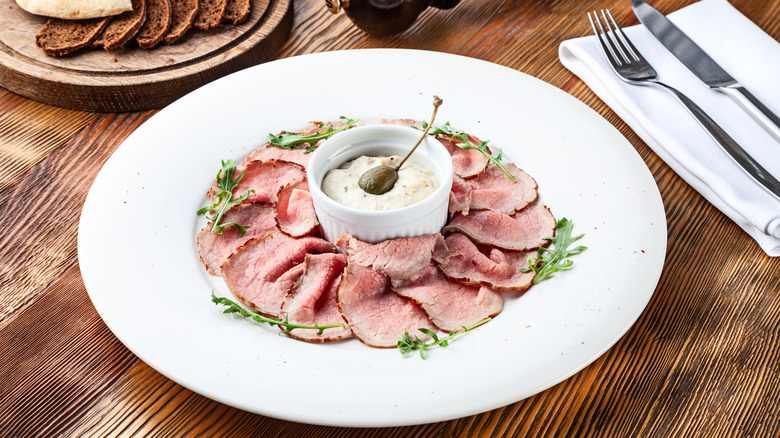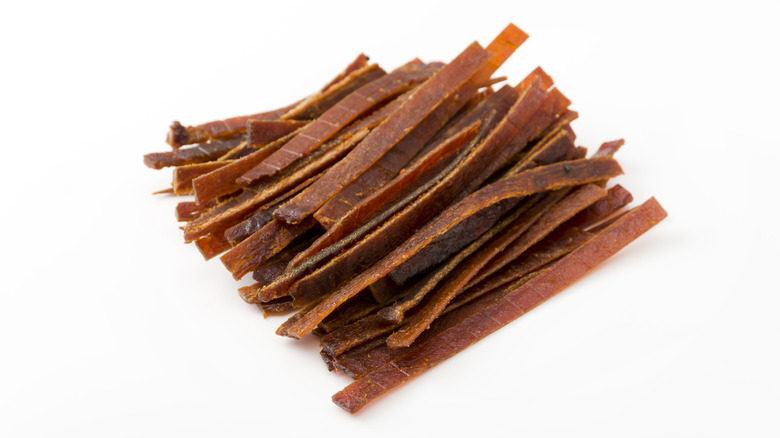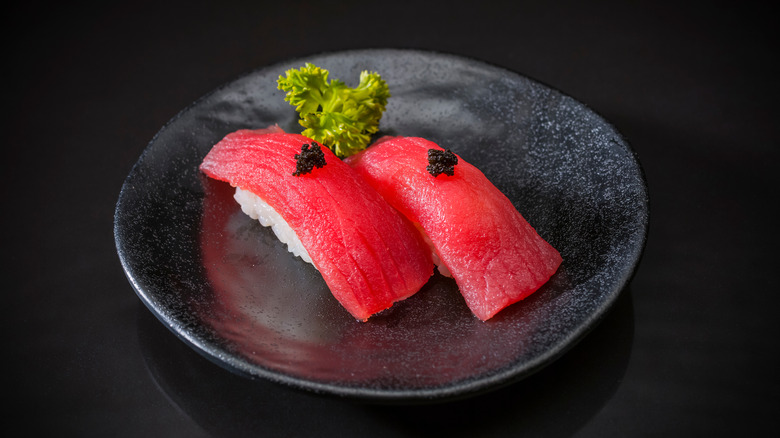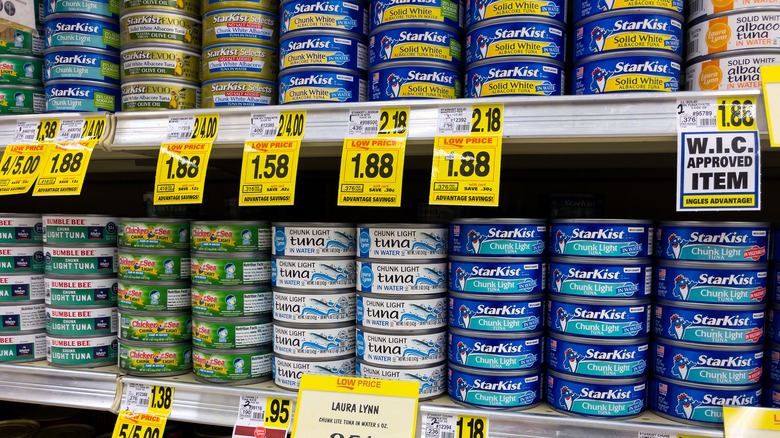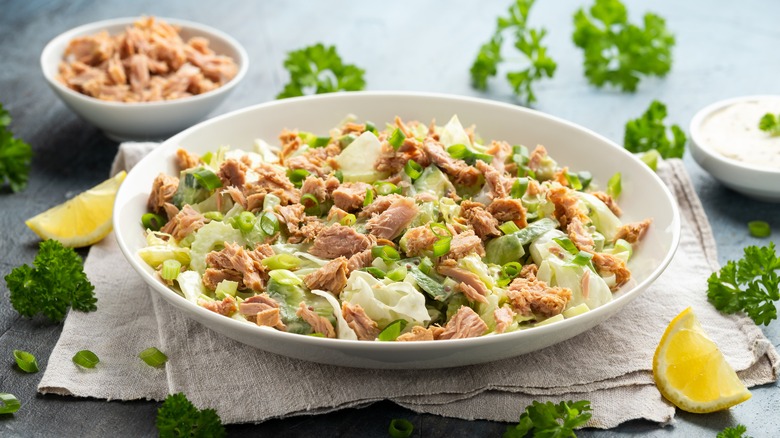Everything You Ever Wondered About Tuna
Tuna is a delicious, nutritious, and extremely versatile fish –– even though it can be a little smelly at times. Along with being widely available around the world, tuna provides a range of valuable nutrients and can be prepared in many different ways (cooked or raw). With so many worthy reasons to eat tuna, it probably won't surprise anyone that demand has soared over the years and a multi-billion dollar tuna industry has emerged.
Unfortunately, the health and supply of tuna have suffered from overfishing, (via the United Nations). This has led to extinction threats and international sustainability efforts among groups like The Nature Conservancy and the World Wildlife Fund. While some species remain severely impacted, others have begun to show signs of recovery, according to the International Seafood Sustainability Foundation (ISSF). And although tuna fishing can sometimes lead to the incidental deaths of dolphins and other wildlife, (per ScienceDirect), dolphin-safe and eco-friendly tuna sources are now available.
Below, we cover everything you ever wondered about tuna, along with some things that may surprise you. After reading the list, be sure to check our tips on making our favorite tuna dishes, such as tuna salad, poke bowls, tuna melts, and seared ahi steak. Enjoy!
There are 15 species of tuna
Scientifically known as the Thunnini family of fish, tunas include 15 separate species, according to National Geographic. These are divided into major and minor subgroups, per ISSF. Major tunas, based on their higher commercial value, include the albacore, bigeye, skipjack, yellowfin, Atlantic bluefin, Pacific bluefin, and southern bluefin species. Minor tunas, which have a lower commercial value, include the slender, bullet, black skipjack, longtail, little tunny, and blackfin species. All tunas are partially warm-blooded, capable of thriving in both warm and cold saltwater.
Although the skipjack species is most commonly used in canned tuna, National Geographic states that it is not a "true tuna." But, no matter: There are plenty of good reasons to eat skipjack. It is an excellent source of protein, along with providing essential nutrients like vitamin D, iodine, and omega-3 fatty acids. Skipjack also contains lower mercury and higher selenium levels than other types of tunas. Perhaps best of all, skipjack is the most sustainable tuna species out there –– so eat up.
Tunas range widely in size
With 15 different species, there is a wide range in size between the smallest and the largest tuna. Bullet tuna are the smallest type of tuna overall, per National Geographic. These little fish weigh in at about 4 pounds and can grow up to a foot long. Of the commercial species, the smallest is the skipjack. These fish can weigh up to 40 pounds and grow to be about 3 feet in length. The skipjack is also the world's most abundant tuna species, according to the World Wildlife Fund. It is frequently used for canning.
The largest (and one of the most threatened) tuna species is the Atlantic bluefin tuna. These impressive fish average 550 pounds in weight and 6.5 feet in length. However, much larger ones have been caught –– including one off the coast of Nova Scotia, Canada that weighed in at a record-breaking 1,496 pounds, (per National Geographic).
Tunas eat other fish
If you're wondering how some tuna species can grow to be so large, it's likely because they are constantly eating –– a privilege from their place at the top of their food chain. Very young bluefin tuna, for instance, start out by eating zooplankton, (via American Oceans). Once they become juveniles, according to NOAA Fisheries, bluefin tuna begin to eat other fish, squid, and crustaceans (like crab, lobster, crayfish, and shrimp). As adults, they mostly eat baitfish (including herring, bluefish, and mackerel), preferring those in the open ocean. They will also swallow whole invertebrates (such as jellyfish). In other words, we can safely say that these enormous fish are not especially picky eaters.
Speaking of constantly eating, all of this talk about tuna is making us hungry. If you have concerns about how often you can eat tuna, the U.S. Food and Drug Administration states that it is generally safe to eat two to three 4-ounce servings of tuna per week. Eating more tuna than that can lead to mercury poisoning. Mercury is a naturally occurring element that can be toxic in high doses to humans, per NutritionFacts.
Tuna is known as the chicken of the sea
Tuna is a fish –– so why is it sometimes called a chicken? Popular tuna brand Chicken of the Sea, which originally started off as Van Camp Seafood in 1914, explains that white albacore tuna used to be described as "the chicken of the sea" among tuna fishermen during the early 1900s. Similar to chicken, white albacore possesses a light color and relatively mild flavor –– plus, who doesn't love chicken? This apt description eventually led to branded Chicken of the Sea tuna products back in 1930.
Here's another funny tuna-related term: tuna fish. We already know that tuna is fish, so why don't we just say tuna? Coastal Angler Magazine theorizes that the term "tuna" on its own describes the fish itself, whereas "tuna fish" refers just to the meat of the tuna like you'd find canned or on a sandwich. This sort of makes sense, right? Except, we don't say "chicken bird sandwich" in the same way (now there's some food for thought).
You can catch tuna with a kite... or with a fly
Since tuna are such fast and agile swimmers, catching them has become a full-blown sport. To this end, a number of interesting fishing techniques have been used. Sport Fishing describes a kite-trolling method for Pacific bluefin tuna in the Southern California and Baja region. In these coastal waters, the species is thriving on an abundance of red crabs. The kite fishing trend, which began around 2014, requires a number of nuances so as not to spook the fish and cause them to dive away. (Tuna can be hard to get close to.) But imagine successfully catching a 300-pound tuna with a kite! We can see the appeal.
Some anglers also catch bluefin tuna via fly fishing. As Salt Water Sportsman describes, this method involves both luck and the right circumstances –– but is well worth the trouble for an extraordinary fishing experience. Fly fishing equipment is best used for smaller tuna, weighing 80 to 100 pounds.
Most commercial tuna fishing outlets use the purse seine technique. Other methods include longline, pole and line, troll, and gillnet.
Most tuna comes from Indonesia
Tuna can be found in the Atlantic, Pacific, and Southern oceans, according to Discover Wildlife. But Indonesia, a country that consists of more than 17,000 islands and is located between the Indian Ocean, Pacific Ocean, and China Sea, is the largest source of tuna in the world. The most common type of tuna found in Indonesia is the skipjack, followed by yellowfin and bullet tunas. Other top international providers of tuna include Japan, Papua New Guinea, Taiwan, Spain, and Ecuador, (per PEW).
Of related interest: Tuna is the most commonly eaten fish in the world, (per Atuna). Countries consuming the most canned tuna include Europe (51%), the United States (31%), and Japan (6%), according to the National Fisheries Institute. In 2018, the U.S. population was responsible for eating 680 million pounds of canned tuna alone. (That's a lot of tuna!) But no matter where you live, there's little doubt that tuna makes for a convenient, tasty, and protein-packed pantry staple.
Fatty tuna (toro) is coveted
Toro, a cut of tuna prized for sushi and sashimi, comes from the fatty belly meat of a bluefin tuna (or maguro in Japanese). As one of the most expensive types of tuna available, toro is coveted for its delicious taste (rich and buttery), appealing texture (melts in your mouth), and even for its relative scarcity. Nutritionally, toro is rich in omega-3 fatty acids, which provide a number of health benefits for the brain and heart. It also contains important vitamins and minerals.
Another main cut of bluefin tuna is called akami. Unlike fatty toro, akami comes from the tuna's loins and is lean, firm, and rich in protein. While akami is also plenty enjoyable, toro is generally considered the superior cut between the two.
Keep in mind that bluefin tuna is not the only type of tuna that can be used for sushi. Yellowfin tuna (sometimes called ahi) is another excellent option. And yellowfin is not only eaten raw; it is also commonly seared. (Don't miss our seared ahi with a sesame crust recipe.) To obtain the perfect sear on an ahi tuna steak, be sure to season and marinate properly, get your pan hot enough, and avoid overcooking.
Some species of tuna are overfished
With tuna being such a popular fish, the unfortunate reality is that some species are overfished, with a subset in danger of extinction. In particular, bluefin tuna has been severely impacted by overfishing, (per WWF). Southern bluefin tuna are now considered critically endangered, while Atlantic bluefin are endangered and Pacific bluefin are vulnerable. Tuna overfishing has mostly occurred during the past 80 years, as worldwide demand has continued to soar. The bluefin population has been reduced by as much as 90% during this period.
In addition to overfishing, climate change has impacted the world's tuna supply. In Japan, for instance, fishermen are noticing warmer waters and changes in the quality and quantity of their tuna catches. Of additional concern, tuna are not the only fish affected. Rising sea temperatures are making it more important than ever to use sustainable, eco-friendly fishing practices. Fortunately, global conservation efforts are coming together to help replenish tuna stocks. And, according to NOAA, the U.S. government is actively encouraging the end of international tuna overfishing.
Tuna is expensive; a single tuna once sold for $3.1 million
Many seafood fans consider bluefin to be the best type of tuna due to its delicious meat. Of course, this type of desire and demand tends to lead to increased prices. In 2019, a single bluefin tuna was purchased for the equivalent of $3.1 million by Kiyoshi Kimura, owner of Sushi Zanmai (a restaurant chain in Japan). The sale occurred during the first tuna market of the year at the Toyosu wholesale market in Japan, (per Seafood Source).
Traditionally, the winner of this annual tuna bidding war obtained bragging rights and increased name recognition. While Kimura continues to hold the record, he declined to participate in bidding during the following COVID-19 pandemic years and auction prices dropped steeply. In January 2023, a 467-pound bluefin tuna sold for $275,000, which was $73,000 more than in 2022, according to the Robb Report. Perhaps the tuna bidding wars are back on the rise.
Although heavily impacted by the COVID-19 pandemic, (via PEW), the tuna industry remains enormous. Global News Wire reported it as a $40.7 billion industry in 2021, with canned tuna comprising over 55% of revenue. However, PEW has expressed concern over the long-term health and value of tuna, citing falling revenues despite an increased catch. This negative shift in revenue may be related to constant growth hurting the industry, along with concern over threatened marine ecosystems.
There are many ways to prepare tuna
There are so many wonderful ways to prepare tuna, particularly since it can be eaten cooked or raw. Some of our favorite tips for cooking with tuna include first selecting the best fresh tuna. When doing so, keep in mind that tuna coloring varies by species and season. Next, be sure to bring your fish to room temperature before cooking. Removing it from the refrigerator 30 minutes prior to use usually does the trick. Also, tuna tastes great marinated, so have some fun by experimenting with different flavors and ingredients. We also recommend choosing the best cooking method, since it is easy to overcook tuna. Many people enjoy seared ahi tuna, which can be eaten on its own or paired with a salad or rice. Just keep a close eye on the time and temperature while searing.
If you prefer to skip cooking tuna altogether, that's no problem. In fact, tuna is one of the only fish that you should prepare raw at home. Nevertheless, be sure to select only sushi-grade tuna for raw consumption, which will reduce any risk of contracting foodborne illnesses. Then, go ahead and get to work preparing raw dishes like ahi tuna poke bowls or tuna tartare. You can also make tuna nigiri or different types of sushi rolls. If you can't find sushi-grade tuna, consider the surprisingly simple swap of replacing raw tuna with canned tuna. You may be surprised at the (tasty!) results.
Tonnato is made from tuna
Tonnato is a type of Italian sauce made from tuna, capers, anchovies, lemon juice, egg yolks, and olive oil, all blended together. Typically served cold, tonnato can be used to add umami to just about any dish. Some foods possess a natural taste of umami, such as meats, seafood, cheese, mushrooms, tomatoes, and fermented foods (per WebMD). Monosodium glutamate (MSG) –– a substance that is sometimes mistaken for umami but that does not occur naturally in foods –– is believed to further enhance the flavor of umami.
But back to tonnato. Umami-rich tonnato is wonderfully creamy, but also tart and tangy. You can use it as a spread on sandwiches, drizzle over roasted vegetables or salads, or dip your favorite raw vegetables into it. Or, try your hand at making a popular appetizer called Vitello tonnato from northwestern Italy (the Piedmont region). This delicate dish involves tender, boiled, and sliced veal topped with tonnato sauce.
And not only does tuna make a great ingredient in a sauce, but tuna is also excellent when covered with sauce. Saucy condiments that go well with tuna include mayonnaise, harissa, and dijon mustard. You can also reach for Greek yogurt, cottage cheese, or crème fraîche to jazz up your canned tuna.
You can make tuna jerky
Although beef jerky is undoubtedly the most well-known of jerkies, jerky can be made from many different types of proteins. Some options include using poultries (chicken, turkey, and duck), pork, wild game (elk, venison, deer), rarer meats (alligator, kangaroo, buffalo), plant-based foods (mushroom and soy), and, of course, fish. Common fish jerkies include salmon, trout, and –– our favorite –– tuna.
Jerky is made by slicing your choice of meat into thin strips, adding flavorings (typically through a brine or marinade), and then dehydrating. The meat retains its nutritional value and you are left with a convenient, shelf-stable protein that can easily be carried in your pocket or purse. Although it is cheaper to make jerky at home, you can also purchase many varieties from grocery stores.
Tuna jerky generally tastes less fishy than fresh fish, so even non-fish fans may enjoy it. And not only is tuna jerky chock full of protein just like beef jerky, tuna jerky is more eco-friendly. When compared to beef products, fish generally leaves a smaller environmental footprint, per Sustainable Fisheries.
The tuna in your sushi might be fake
Not to be a downer, but the tuna in your sushi might be fake. A shocking 2013 study by Oceana revealed widespread seafood fraud in the U.S. To investigate the accuracy of seafood labeling, Oceana gathered over 1,200 samples from 675 retail outlets in 21 states, then conducted DNA testing. They discovered that 33% of the samples were mislabeled, with snapper (87%) and tuna (59%) being the most common victims.
In a related study by Oceana several years later, things didn't look much better. Of over 25,000 seafood samples tested around the globe, 20% were mislabeled. And perhaps of even greater concern, Time reported that the majority of mislabeled seafood products could potentially lead to health issues for some people.
Before shelling out for bluefin tuna or other types of expensive fish, you may want to ask your grocer (or server, if eating out) where the fish originates from. Some outlets provide QR codes for product tracking, allowing for full transparency from sea to plate, (via Seafood Source).
Not all tuna brands are created equal
Whether you're making a basic tuna sandwich, an upgraded tuna melt, or a classic tuna casserole, you are going to need to decide which tuna brand to purchase. Although many of us grew up eating Starkist, Chicken of the Sea, and BumbleBee, our favorite tuna brands now include Scout, Ortiz, American Tuna, and Tonnino. Additionally, Wild Planet, Raincoast Trading, and Great Value tuna brands are some top picks –– so you may want to give these a try, too.
When deciding upon which tuna brand to buy, there are a number of things to consider, including flavor, cost, and environmental impact. Through product testing, we generally found that the more expensive brands tasted better, as did tuna packed in oil (versus water). But there is also an environmental cost to consider since some brands use safer fishing techniques to protect fragile ecosystems and avoid harm to dolphins and other marine species. Monterey Bay Aquarium encourages tuna shoppers to choose sustainable seafood products, offering an informative consumer guide to help with your selections. Note that skipjack tuna, often used for canning, is rated as a "best choice" –– but only when originating from the Pacific and caught with trolls or poles and lines.
There are many ways to elevate your tuna salad
Ah, tuna salad. While it may be a little smelly, it can also be pretty darn delicious. Many tuna salad recipes are pretty simple, involving common ingredients like mayonnaise, mustard, and relish. But if you're tired of eating the same-old, same-old tuna salad, we have some thoughts on how to elevate it into something far more appealing.
One option is to prepare your tuna salad with fresh tuna. While perhaps not as convenient as using canned tuna, fresh tuna gives you a lot more flavor options. You can brine fresh tuna any way you want, and then grill or even poach it. Note that poaching fresh tuna will help you obtain the closest consistency (along with an upgraded flavor) to canned tuna.
You can also experiment with various add-ins. One of our favorite ingredients for tuna salad is avocado, which can either replace or accompany mayonnaise. We also love playing around with green goddess dressing, fresh dill, lemon pepper seasoning, curry powder, and shallots –– but don't let us stop you there. Get creative and consider adding jalapeños, parsley, hot sauce, or even pickle juice. Indeed, there are countless available options to elevate your tuna salad.
There are health benefits to eating tuna
Eating tuna can positively impact your health. This is because tuna is packed with protein and other important nutrients. VeryWell Fit reports that a single can of tuna provides a whopping 42 grams of protein, along with plenty of omega-3 fatty acids and essential vitamins and minerals. Some of these include calcium, phosphorus, potassium, zinc, B vitamins, selenium, and choline.
Each of these important nutrients helps support proper functioning in the body. Vitamin B12, for example, helps the body make DNA and new red blood cells while preventing anemia, (via WebMD). Eating enough omega-3 fatty acids, on the other hand, can reduce your risks of cardiovascular disease and even heart attack. Omega-3s can also improve your vision, help you manage your weight, and reduce the risk of developing cancer.
On the downside, you do need to consider what you are eating with your tuna in order to maximize potential health benefits. Adding fresh vegetables to tuna –– such as cucumber, celery, and carrots –– can offer its own set of positive health benefits.
